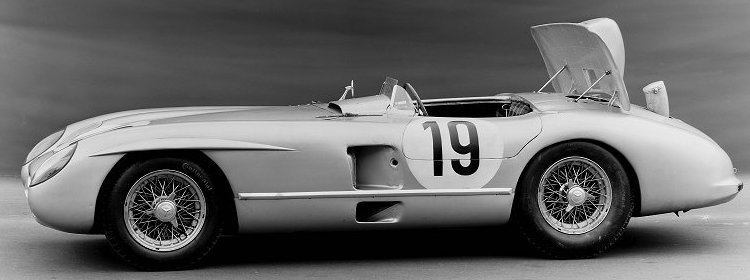
|
|
  





|
|
The development of the 300SLR racing sports car was heavily influenced by the Mercedes Benz 300 SL with striking gullwing doors, which first lined up at the start of the Mille Miglia in 1952 and a road-going version of which made its debut in February 1954. It was this famous model which provided the basic concept for the new racer, featuring a lightweight but high-strength tubular steel frame supporting an aluminium body. However, the 300SLR also stood out with a host of individual characteristics very much its own. These included a five-speed transmission, 16-inch wheels and larger brakes.
Above all, though, the racing sports car developed far greater output than its 'little brother' the SL - an eight-cylinder engine with petrol direct injection and dual ignition, essentially the same unit which powered the 1954 Formula 1 racing car, saw to that. The Monoposto and Stromlinie open-top body variants of the W 196 R Silver Arrow had chalked up numerous victories in international events, including the French Grand Prix, the Nürburgring race, the Italian Grand Prix, the Avus race in Berlin and the Argentinean Grand Prix. The displacement of the Formula 1 eight-cylinder power unit was increased from 2.5 litres to 3.0 litres for use in the 300SLR racing sports car. This boosted out-put to as much as 310 hp at 7400 rpm, depending on the intake manifold. Maximum torque of 317 Newtonmetres at 5950 rpm ensured quite majestic pulling power. The hugely powerful engine was mounted longitudinally in the front section of the car at an angle of 33 degrees and supplied with a high-octane fuel mixture of low-lead petrol (65 percent) and benzol (35 percent). In some races, alcohol was also used to push performance up to even greater heights. As a rule, the racing sports car roared off the starting line with 167 litres of fuel and 35 litres of oil on board. Production: 2 cars. |
|
General |
Engine |
Performance |
|
Year : 1955 Make and Model : Mercedes Benz 300SLR Curb Weight : 900 kg Layout : Front Longitudinal 53 Degree Inclination to the right Engine/RWD Transmission : Rear Mounted 5-Speed Manual |
Configuration : Type M196S TwinSpark Inline-8 Displacement : 2982 cc Power : 310 bhp (231.2 kw) @ 7400 rpm Torque : 317 nm @ 5950 rpm Redline : 7800 rpm |
Top speed : 300 kmh (186.4 mph) Acc. 0-100 kmh : --s Acc. 0-160 kmh : --s Acceleration 0-¼ mile : --s Lateral Acc. : --g |
|
|
Site created by Alin Sãndulache |
|